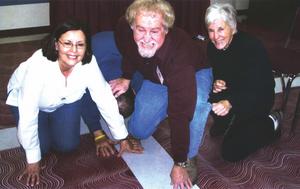

Participants in an Improvisation & Creative Movement class have fun while solving a problem. The class provides exercises not only for the body, but also for the mind and imagination.
Anne Armentrout, 60, loves playing with words, and inspiring others to do so. She has a graduate degree in English from Georgetown University and a career spanning three decades as a writer, editor, teacher, director, dramaturge, artist, and entrepreneur.
Improvisation & Creative Movement is right up her alley, so she offered to share the teaching side of this story.
"The class provides exercises not only for the body, but also for the mind and imagination. It gives folks the chance to play and have fun even as they work to quickly solve a problem or respond to changed circumstances. 'Doing improv' requires, and helps improve, focus, concentration and flexibility,"
she explains.
"We start each class with gentle stretching andsometimes called theatergames. Some are purely physical; some, verbal; others, both. Some exercises are done to music and others are not. Some exercises are performed by individuals; others require working in pairs, trios or as the whole group together."
She continues, "We do simple exercises such as pairing up and taking turns mirroring the other person's movements. Or, everyone might move to music using whatever body part the facilitator calls out, 'Lead with you left ear.... Follow your right knee....Now go with your belly button.'
"One of the most popular exercises is 'Whatcha doin'?' A person mimes an action - say, brushing her teeth - then another person asks, "Whatcha doin'?" The first person must instantly make up a completely different action, while continuing to mime the original - for example, 'I'm walking the dog.' The second person then mimes walking the dog, until the next player asks, 'Whatcha doin'?' and gets another at-odds answer that determines what he must begin miming. It's a great exercise for
concentration and quick thinking - and lots of fun!"
MEET LOCAL SENIORS who are passionate about The Arts and education.
-- SEAN O'SULLIVAN, 87, views the College for Older Adults as "a jewel in the mountains." He says, "It's like a social mixer, also. I've met people there that I would not have met otherwise."
-- ALMA RIGBY, 73, can usually be found taking one of Virginia Intermont's classes for seniors: "I love to do things with young people."
-- JOAN HORSCH, 76, has participated in the Arts Array Film Discussions for 10 years: "The film discussions are really interesting because someone else always sees something you didn't see or has an extremely different impression of what the ending means."
-- REBECCA HARRINGTON, 64, has been swept away in The Barter Experience: "I almost didn't go see Dracula, thinking 'how many times do I need to see that production?' But I went to the theaterand I'm so glad I did."
-- CAROL BELL, 67, joins in discussions at SVHEC about women writers: "Some people mention other books. Everyone does away with news things to read and a new focus on the Appalachian region and the writers."
-- PROGRAMS for older adults available in the region.
-- HISTORIC EXAMPLES: The Arts & the Brains of Older Adults
-- BACK to the main story: "The Arts & the Brains of Older Adults."